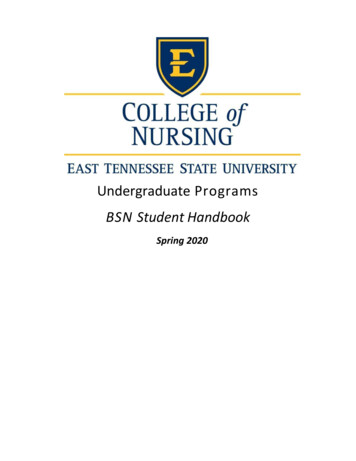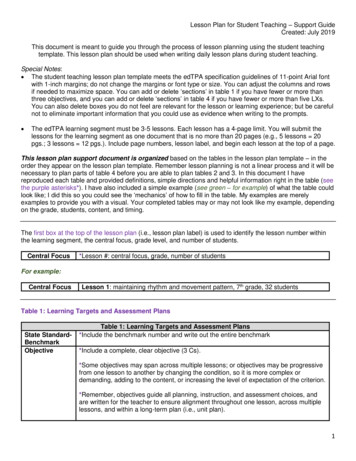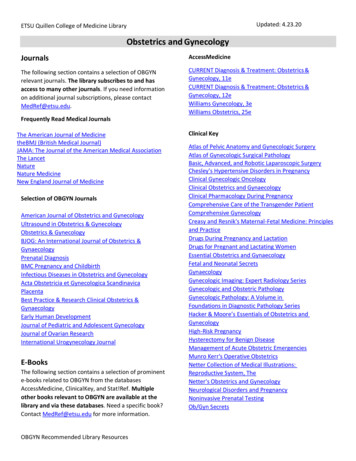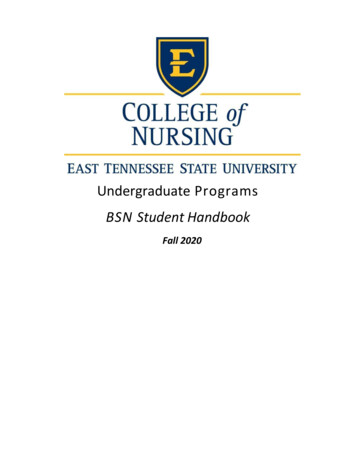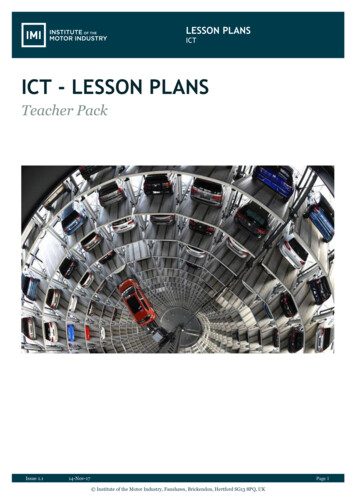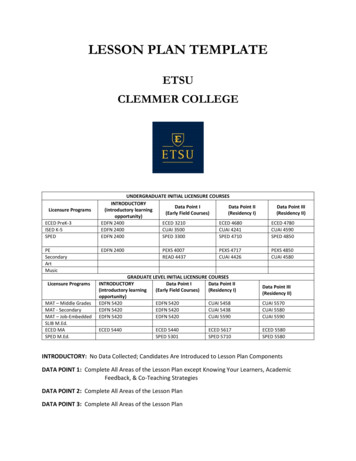
Transcription
LESSON PLAN TEMPLATEETSUCLEMMER COLLEGELicensure ProgramsECED PreK-3ISED K-5SPEDPESecondaryArtMusicLicensure ProgramsMAT – Middle GradesMAT - SecondaryMAT – Job-EmbeddedSLIB M.Ed.ECED MASPED M.Ed.UNDERGRADUATE INITIAL LICENSURE COURSESINTRODUCTORYData Point IData Point II(introductory learning(Early Field Courses)(Residency I)opportunity)EDFN 2400ECED 3210ECED 4680EDFN 2400CUAI 3500CUAI 4241EDFN 2400SPED 3300SPED 4710EDFN 2400PEXS 4007READ 4437PEXS 4717CUAI 4426GRADUATE LEVEL INITIAL LICENSURE COURSESINTRODUCTORYData Point IData Point II(introductory learning(Early Field Courses)(Residency I)opportunity)EDFN 5420EDFN 5420CUAI 5458EDFN 5420EDFN 5420CUAI 5438EDFN 5420EDFN 5420CUAI 5590ECED 5440ECED 5440SPED 5301ECED 5617SPED 5710Data Point III(Residency II)ECED 4780CUAI 4590SPED 4850PEXS 4850CUAI 4580Data Point III(Residency II)CUAI 5570CUAI 5580CUAI 5590ECED 5580SPED 5580INTRODUCTORY: No Data Collected; Candidates Are Introduced to Lesson Plan ComponentsDATA POINT 1: Complete All Areas of the Lesson Plan except Knowing Your Learners, AcademicFeedback, & Co-Teaching StrategiesDATA POINT 2: Complete All Areas of the Lesson PlanDATA POINT 3: Complete All Areas of the Lesson Plan
Lesson Title:Grade/Level:Date/Learning Experience #:Curriculum StandardsEssential Question(s)/I Can Statement(s)State Curriculum Standards – Underline your language/vocabulary wordsWhat question(s) or I Can statement(s) drive your instruction?Lesson Objective(s) – Student Learning Outcome(s) for this learning experienceObjectives use active verbs, are measureable (if applicable), and link to standards. Consider using Bloom’s Taxonomy or Webb’s Depth of Knowledge.Knowing Your LearnersDescribe pre-requisite skills students already know that will help them meet the lesson objective(s). What is your evidence that students need this/these skills(s)? This may includepre-assessment data; student personal, cultural or community assets you have gathered and observations you have made concerning your students.Assessment/EvaluationHow will students demonstrate understanding of lesson objective(s)?How will you monitor student progress towards lesson objectives as you are teaching? (i.e., formative,informal, and/or formal assessments)What evidence will you collect and how will you document student learning/mastery of lessonobjective(s)? (i.e., formal OR summative)Academic Feedback: How will you give academic feedback? How will your academic feedback promote student understanding of thelearning objective(s) or state standard(s)?Academic Language DemandsAssessment/EvaluationModificationsWhat modifications will you makeon assessments/evaluations forstudents with diverse and/or specialneeds (i.e. students with IEP or 504,struggling learners, advancedlearners) and will these modificationsbe within/for small groups orindividuals?
Function and Product of the Lesson The function is the verb, usually a Blooms verb (e.g., analyze, interpret, recount), that guides the language objective of the lesson.This includes a product that students will either write, say, present, or do that involves Academic Language (e.g. essay, present, recount).Academic Vocabulary What specialized terms and phrases do students need to understand what they are expected to do? How does this vocabulary connect to the objectives,state standards and function of the language demand?Content Vocabulary What are the key vocabulary words, symbols, or sounds in this lesson? How does this vocabulary connect to the objectives, state standards and functionof the language demand?Syntax and/or Discourse, Mathematical Precision (math only). This section is not required for Early Childhood or Special Education.Syntax What are the specific ways or conventions for organizing symbols (e.g., linear, horizontal), words (grammar), phrases, or graphics that students need to know to be able todo what you are asking?Discourse What are the specific ways in which members of a discipline (e.g., scientist, historian, etc.) talk, write, and communicate knowledge that students need to know to beable to do what you are asking (e.g., essays, presentations, performance, journal, debate, historical account, signal)?Language Supports What general instruction will you provide to help students in the whole class (e.g., word walls, learning partners, guided notes) learn thediscourse/syntax? What focused instruction (e.g., Venn diagrams, graphic organizers, outlines, student examples, sentence stems) will you provide to help students learn thediscourse/syntax (can be completed in small groups)? What individual instruction that targets the needs of an individual student(s) will you provide to help that student(s) learnthe discourse/syntax? What opportunities will you provide for students to practice language/vocabulary and develop fluency? What tools (e.g., EQ or vocabulary board, Venndiagram, anchor chart, vocabulary cards, graphic organizer, peer support, sentence stems, pictures, table, chart, thinking map, modeling, sort, song, body movements, games) willyou use to help students meet the language demands?General Supports – Strategies used to support the whole class and may be used to support more than one demand (e.g., Venn diagram, learning partners, wordwall, anchor chart, vocabulary cards, graphic organizer, sentence stems, pictures, table, chart, thinking map, modeling, sort, song, body movements, games). Thesestrategies can cross disciplines and be used in a variety of lessons.Targeted Supports – Strategies that focus toward a specific language demand (e.g., Venn diagrams, graphic organizers, outlines, examples, sentence stems). Thesemay be addressed during small groups. These can be general supports that are modified for specific students or groups of students.Individual Supports – Supports used to target the specific needs of an individual student (e.g., ELL, student with autism, struggling reader or writer, studentwith significant language delays). These students may or may not have been formally identified and may or may not have an IEP or 504 plan.Instruction – When designing your instruction, consider when you will implement formal and informal assessments/evaluations, whenyou will provide feedback, and when you will teach academic language. Therefore, this section should include aspects written above.Lesson PartDescription of Activities and Instruction(Teacher Does)Description of Activities and Instruction(Students Do)MeetingIndividual &Group Needs
Plans instruction to meetthe needs of individualstudents. Adaptations aretied to learning objectives.Specific individual or grouplearning includesrequirements in IEP or504 plans.Set/Motivator: Restateand address your EssentialQuestion. How do youengage student interest inthe content of the lesson?How does this relate toprevious learning? Useknowledge of students’academic, social, andcultural sks: Provide specificstep-by-step details of lessoncontent aligned withobjectives, utilizing avariety of teachingstrategies.Questions and/oractivities for higherorder thinking: Theseare open-ended and cannotbe answered by yes or no.These can be asked atvarious points throughoutthe lesson and guide ratherthan direct studentthinking.Closure: Makes clearconnections to real-worldsituations and requiresstudents to reflect on andapply their learning throughverbal or writtenexpression.Material/Resources: What do you need for this lesson? Identify, within a bulletedlist, the specific materials and resources that you will use. Describe how these materials andresources add value, depth, and extend students’ learning.Technology: (a) Describe the technology you plan to use in your lesson, (b)How does the identified technology in your lesson improve student learning? Ifapplicable, (c) explain how you will use this technology to support a variety ofstudent needs within the learning environment, and (d) If you used this technologyto design and implement formative and/or summative assessments, please explain.Did you use the technology to collect and/or analyze your data to informinstruction? Explain.
Co-Teaching Strategies Used: (highlight and explain all that apply): One Teach, One Observe; One Teach, One Assist; Station Teaching; Parallel Teaching; SupplementalTeaching; Alternative (Differentiated); Team Teaching
Licensure Programs INTRODUCTORY (introductory learning opportunity) Data Point I (Early Field Courses) Data Point II (Residency I) Data Point III (Residency II) MAT - Middle Grades EDFN 5420 EDFN 5420 CUAI 5458 CUAI 5570 MAT - Secondary EDFN 5420 EDFN 5420 CUAI 5438 CUAI 5580 MAT - Job-Embedded EDFN 5420 EDFN 5420 CUAI 5590 CUAI 5590 .

